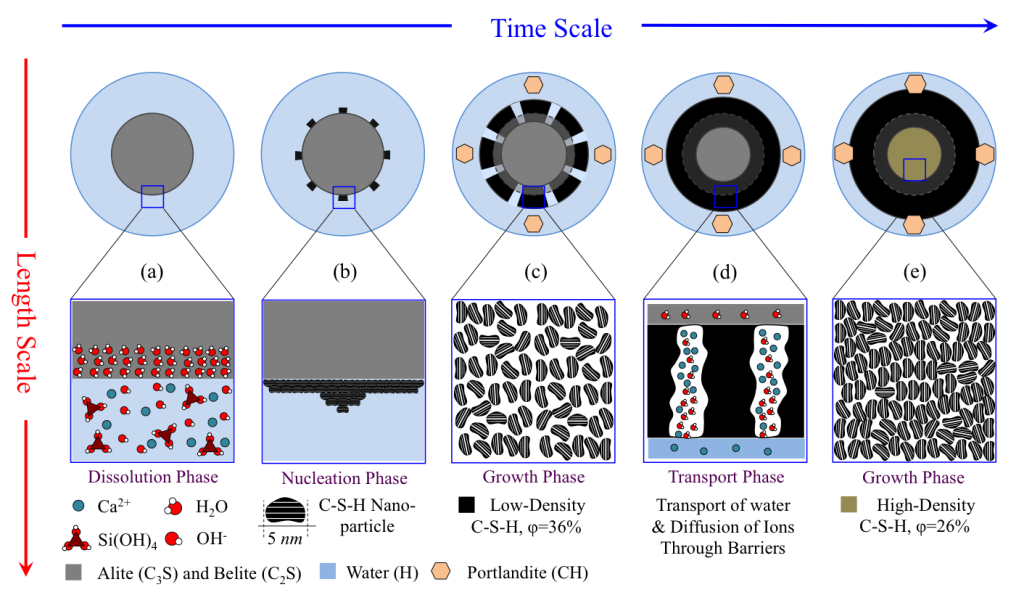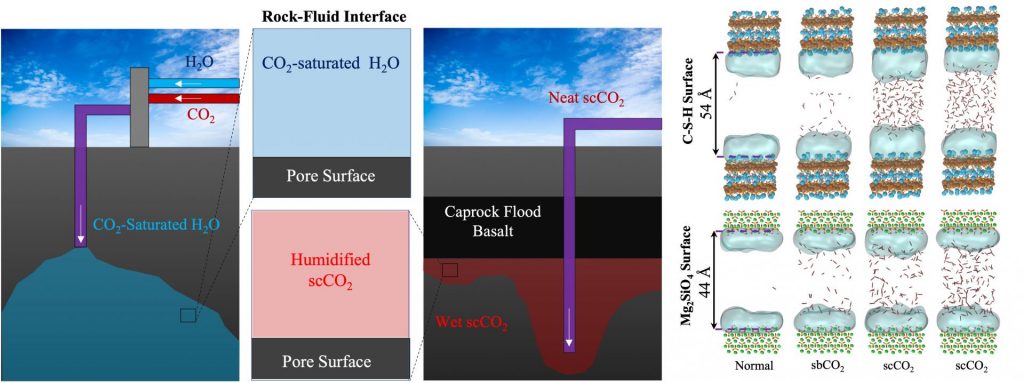Scope and Goals:
The overarching scientific objective of our research group is to understand interfacial phenomena. Interfaces are abundant in natural and man-made systems and occur when two dissimilar materials meet each other, i.e., solid-solid, solid-liquid, liquid-liquid, solid-gas, and liquid-gas interfaces. Our group specializes in the fundamental understanding of peculiar mechanics, chemistry, and physics at such interfaces. Although fundamental in nature, our research aims to address applied research questions ranging from the fate of carbon dioxide in geochemical reservoirs to the design of sustainable infrastructure materials. We address such seemingly diverse problems through the lens of physical chemistry. To this end, we develop numerical modeling tools (e.g., transferable force fields and molecular structures) and combine them with state-of-the-art in situ and ex situ experiments. Together, simulations and experiments provide a mechanistic picture of the underlying physicochemical processes at the nanoscale. Ultimately, such information will be used to optimize processing conditions or design variables to enhance chemical reactivity, improve mechano-physical material properties, and reduce the environmental footprint of engineered materials. In what follows, we briefly describe the main active research areas in our group. In the meantime, the interested visitors are referred to the Publications Page and the PI’s Google Scholar webpage for most recent science products.
Geochemistry and Geophysics Research:
Geosystems and subsurface phenomena are rich in unique interfacial processes that remain poorly understood. The examples include nanoconfined mineralization and biomineralization processes and their relation to the deep carbon cycle and the geological carbon sequestration. Understanding interfacial phenomenon has direct implications in projecting energy-related contaminants’ fate in geosystems and a plethora of soil-hosted reactions. Our group is conducting cutting-edge research on carbon dioxide’s fate in the subsurface with applications in carbon mineralization in basalt formations and zero-net carbon footprint energy resource recovery from unconventional reservoirs. Together with in situ and ex situ experimental measurements, our group aims to understand the molecular mechanisms of carbon dioxide interaction with rocks and leverage this fundamental understanding to improve sequestration and energy harvesting processes.
Cement Chemistry Research:

Our group’s other research interest lies within the broad area of construction materials’ applied physical chemistry. This multidisciplinary field is at the interface of physics, chemistry, materials science, and solid mechanics. Over the years, our group has developed predictive physics-based tools for optimizing the physical attributes (mechanical and thermal properties) of cementitious materials. For instance, cement paste, the glue of concrete, is a multiscale porous material that exhibits distinct physical features at multiple length scales. While its nanoscale and microscale properties are well studied, its mesoscale (10-100 nm) attributes cannot be addressed via conventional physics- and mechanics-based approaches. The mesoscale phenomena are neither small enough to be studied with particle physics methods nor large enough to be described with mean-field homogenization theories. Our team is developing tools to answer intriguing questions regarding cement paste’s texture at the mesoscale and its implications on the physical properties. The ongoing research projects include organic-inorganic cementitious hybrids for thermal insulation and studying surface forces in cementitious composites and their impact on macroscale strength development.
Research Hobbies: (Science of Cities & Statistical Mechanics)

The tools and techniques developed and employed by the PI’s group transcend the conventional realm of interfacial phenomena in geosciences and cement chemistry. As a hubby, the PI, his research group, and collaborators across the country apply statistical physics tools to a wide array of problems ranging from the physical theory of cities to the impact of thermal fluctuations on the critical buckling load in thin elastic sheets. Our group aims to combine the tools of computational physics with classical solid and fluid mechanics to describe emerging phenomena and address environmental resilience and sustainability issues in a theoretical framework. The ongoing research projects are focused on the physics of flooding in cities.
